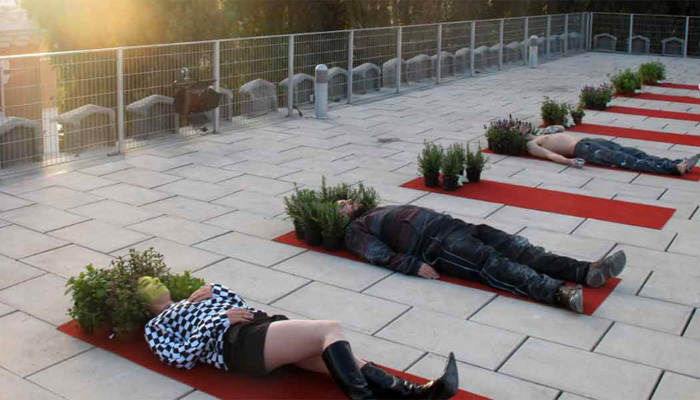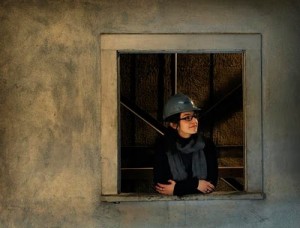
Interview with Paola Santoscoy
When Paola Santoscoy met Adam Lerner in Autumn 2008, she had no idea that the encounter would lead her to Denver to curate a portion of the Biennial of the Americas. At the time, she was a student in the Curatorial Practice MA program at the California College of the Arts. Lerner was still the director of the LAB at Belmar. They talked about the artist Melanie Smith with whom both had worked. Lerner then invited Santoscoy to participate in “B+ (Very Good) Explanations: An Old Fashioned Smackdown” at MCA/Denver in October 2009, an event that pitted Lerner against young curators to argue why or why not they are convinced by some the worlds most difficult contemporary art. A month later, Lerner sent “Punchin Paolas” vitae to the Denver Office of Cultural Affairs and she had one weekend to decide whether or not to take on the enormous task of curating an international art biennial in less than six months.

Paola Santoscoy
Santoscoy said yes and her exhibit, “The Nature of Things” opens on July 1 at the 28,000 square foot McNichols Building in Civic Center Park. The building itself was one of the things that compelled her to say yes. “Its not a white cube, but a historic building in the process and stages of renovation. I thought it was a very generous space with the potential to do specific things and was a good platform for create something in terms of an exhibition project,” Santoscoy said as we sipped coffee in the Highland neighborhood where she is living temporarily while in Denver. In Santoscoys exhibit, the artists and their works will take over the building and use all of the spaces, even the unexpected ones. She envisions an exhibit that is about curiosity and subverting the viewers reality.
Santoscoy is calling on her previous experience to pull off the exhibit in such short notice. The 35-year-old has been working with artists since college and her experience includes two museums, a nonprofit art space, and independent art organization. But shes found herself drawing more on the independent project experiences to help her with the Biennial. “The projects you put together very quickly and more intuitively. Its fast. It comes. And it is what it is,” she said. She invited artists, designers and architects with whom she was already familiar and the show she says “self-generated.” Many of the artworks needed a counterpart or complementary, a point of departure that would lead her to another artist. Some of the more ambitious projects and concepts could not be completed in the limited time frame so another artists project was selected instead. In total, 24 artists are participating in the exhibit, most are producing new work, something Santoscoy preferred to facilitating the re-exhibiting of existing projects. “The artists are amazing,” she added. “They really wanted to do something and they know the situation and the time frame.”
“The moment it started coming together is when the artist voices started entering the scene. Its their voices, criticisms, and ideas that really made the project stronger,” she said. “Those voices and conversations are the creative core of the project. Thats what brought it to life.”

Teddy Cruz
Santoscoy knows there are a lot of expectations, but shes realistic. “Im doing whats possible with the time I have and the resources. There are some truly amazing projects being developed for this exhibit. Jeronimo Hagerman is producing his largest installation ever in the U.S. for “The Nature of Things” that includes an exterior intervention with plants (see top photo). Teddy Cruz project involves documenting an architectural phenomenon happening in San Diego, where old houses are being moved to Tijuana instead of being torn down. Gregory Euclide, a Minnesota artist represented by Denvers David B. Smith Gallery is creating a large capture installation that explores the relationship between man and nature. Karlo Andrei Ibarra from Puerto Rico is exhibiting a neon sign that reads: Yo vivo en Estados Unidos. It will be powered by a solar panel attached to the building. Gabriel Acevedo Velarde from Peru is creating a new video installation about vandalism in Lima. And Rael San Fratello Architects from Oakland, California who are most well known for their “Prada, Marfa” project are presenting an algorithm that localizes public spaces in a city that are not developed.”We are planting seeds to spark conversation. Not that its not coherent, there are strange ups and downs. I believe in the works I selected, but there are parts where the connections are stronger and others are not as strong,” she said.

Rael San Fratello Architects
In the end, “The Nature of Things,” which is taken from an epic by the Roman poet Lucretius, is about perception and how we see the world. Lucretius believed that periodically a few enlightened individuals can escape from human hungers and passions to find compassion on humanity, which on average he viewed as ignorant, unhappy, and yearning for something better. Just as Lucretius poem was overly ambitious in attempting to explain different phenomenon in the universe, the exhibit is also ambitious in bringing to light issues that are current and relevant in all of the Americas–not just the U.S. The art will be incongruous from the hermetic exterior of the building and the exhibit promises to be challenging and to raise the question about what is the nature of art today
